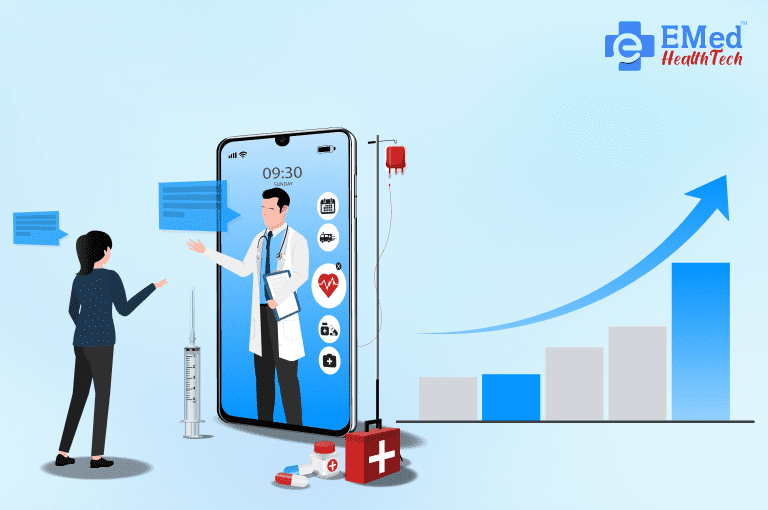Telemedicine Platform has rapidly become one of the most revolutionary aspects of modern healthcare. It’s role in medical services expanding each year, the future of telemedicine is filled with incredible potential. As 2025 approaches, telemedicine platform is set to transform patient care even further, improving access, reducing costs, and enhancing healthcare delivery. The ongoing telemedicine innovations will alter the relationship between healthcare providers and patients, driven by the worldwide trend toward digital healthcare solutions.
In this blog, we will explore the latest telemedicine trends and what we can expect by 2025.
Telemedicine Platform in 2025: A Quick Overview
Several factors have contributed to the fast-paced evolution of telemedicine, particularly the COVID-19 pandemic, which accelerated the shift toward virtual healthcare. Even today, patients and healthcare providers view telemedicine platform as an essential component of everyday healthcare.
By 2025, telemedicine trends suggest it will become a more mainstream part of healthcare systems, supported by digital advancements and increased mobile technology. Improved internet infrastructure, especially in rural and underserved areas, the demand for convenience, and mobile app development are driving this growth.
Regulatory bodies are also playing a more positive role by crafting rules that encourage healthcare providers to adopt telemedicine technology. By 2025, telemedicine platform will focus on improving access to care and enhancing patient outcomes using telemedicine innovations that are personalized and data-driven.
Top Trends Shaping Telemedicine Platform in 2025

-
Integration of AI and Machine Learning in Telemedicine
Artificial Intelligence (AI) and Machine Learning (ML) will play a crucial role in the future of telehealth. AI-driven diagnostic tools can analyze real-time patient data and assist medical professionals in making faster, more informed decisions. For example, telemedicine innovations such as AI-powered virtual assistants will help automate routine tasks like symptom checks, appointment booking, and patient triage.
Machine learning models can process large datasets, enabling predictive analysis and customized treatment plans. This means that healthcare providers can offer more precise care, driving the increasing demand for telemedicine platform with advanced, AI-powered features.
-
Remote Patient Monitoring & Wearable Healthtech
Wearable health technologies, such as smartwatches and fitness trackers, will continue to evolve in the future of telehealth. These devices can monitor vital signs like heart rate, blood pressure, and oxygen levels in real-time, providing healthcare providers with invaluable data for proactive care management, particularly for chronic conditions.
By 2025, telemedicine innovations will include tighter integration between these wearables and telemedicine platforms. This will allow for automatic alerts when abnormal readings are detected, enabling healthcare professionals to respond quickly. The convenience of remote monitoring will significantly improve patient outcomes, while also benefiting healthcare providers by providing real-time data for clinical decisions.
-
5G Connectivity Transforming Telemedicine Platform
The rollout of 5G networks will revolutionize telemedicine trends by providing faster speeds and lower latency. High-definition video consultations will become the norm, making virtual appointments feel as close to in-person visits as possible.
5G will also close the connectivity gap in rural areas, where poor internet infrastructure has hindered telemedicine adoption. With enhanced 5G connectivity, telemedicine innovations will make quality healthcare accessible to patients in remote areas, significantly improving future of telehealth for underserved populations.
-
Using Telemedicine to Expand Mental Health Services
By 2025, telemedicine will be a critical tool in delivering mental health services. Today, virtual counseling and therapy are already widely used, but telemedicine trends suggest that even more comprehensive mental health solutions will be integrated into telemedicine platforms.
Features such as mental health assessments, self-care tools, and cognitive behavioral therapy modules will be available, offering a more holistic approach to mental health care. Telemedicine apps will offer a private, convenient way to seek help, reducing the stigma around mental health care and improving accessibility for patients.
-
Telemedicine Platform for the Treatment of Chronic Diseases and Elderly Care
Patients with chronic conditions and elderly individuals stand to benefit the most from the future of telehealth. Telemedicine platforms allow for continuous, real-time monitoring, customized treatment plans, and virtual consultations, reducing the need for in-person visits and minimizing exposure to potential infections.
Specialized telemedicine apps designed for elderly patients will include features such as medication management, easy navigation, and intuitive interfaces, enhancing their quality of life. The ability to create telemedicine platform customize to specific patient needs is one of the most exciting telemedicine innovations for elderly care.
The Role of Telemedicine Platform in Future Healthcare
-
Development of Custom Telemedicine Apps
The demand to create telemedicine apps tailored to specific healthcare needs will only grow. Custom telemedicine apps can offer virtual consultations, AI-powered diagnostics, remote monitoring, and personalized health plans. Specialized telemedicine applications for fields like cardiology, dermatology, and mental health will allow healthcare professionals to provide targeted, effective care.
By 2025, developing personalized telemedicine solutions will be key to improving healthcare access and patient outcomes. Tailored apps will enable medical professionals to deliver care that meets the unique requirements of their patients.
-
Interoperability and Integration with EHR Systems
By 2025, a major advancement in the future of telehealth will be the seamless integration of telemedicine apps with electronic health records (EHRs). More telemedicine platforms will be designed to integrate patient data from EHRs, allowing healthcare providers to access comprehensive information during a virtual consultation.
This interoperability will enhance decision-making, reduce errors, and improve the overall quality of care, as healthcare professionals will have a complete view of a patient’s medical history during a telehealth appointment.
-
Personalized Patient Experience Through Telemedicine Apps
Personalization will be a dominant trend in telemedicine app development. Patients increasingly expect tailored care, and telemedicine platforms are no exception. Telemedicine trends indicate that apps will track patient progress, provide personalized health recommendations, and schedule follow-ups based on individual needs.
By providing a more customized experience, telemedicine apps can increase patient engagement and adherence to treatment plans, significantly enhancing healthcare outcomes.
Challenges and Opportunities in Telemedicine Platform for 2025
-
Resolving Security and Regulatory Issues
As telemedicine expands, concerns about data security and privacy remain paramount. By 2025, telemedicine apps will need to adhere to stricter regulations governing the transmission and storage of sensitive patient data. Advanced security measures, such as end-to-end encryption and blockchain technology, will play a crucial role in safeguarding patient data and building trust in telemedicine platforms.
-
Closing the Digital Gap in Telemedicine
While telemedicine is advancing rapidly, there is still a digital divide to address, particularly in rural and underserved areas. Investments in digital infrastructure, internet access, and digital literacy programs are essential to ensure that everyone can benefit from telemedicine services.
Conclusion
By 2025, telemedicine platform will continue to play an increasingly vital role in healthcare delivery. The future of telehealth will undoubtedly be shaped by telemedicine innovations such as AI integration, wearable health technology, and 5G connectivity.
These trends will drive more personalized, efficient, and accessible healthcare solutions, improving patient outcomes globally.
If you’re ready to take your medical services to the next level, partner with EMed Healthtech to build a telemedicine platform designed specifically for your healthcare needs.










